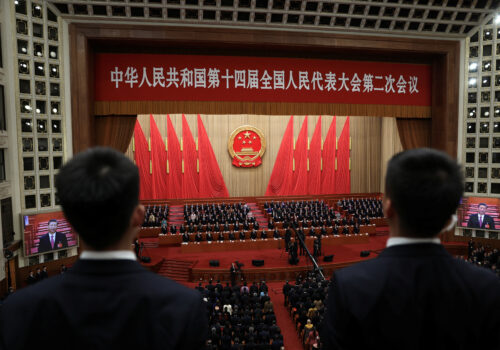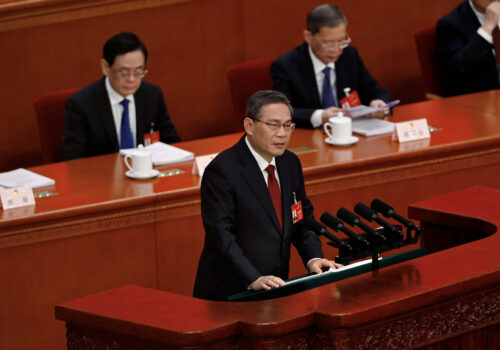There’s less to China’s housing bailout than meets the eye
Beijing grabbed headlines last week by declaring its resolve to address the country’s deep property slump with 300 billion yuan ($42 billion) of central bank funding for state-owned enterprises to buy up vacant apartments. That money, along with relaxed mortgage rules, briefly offered a slight hope that the government finally is coming to grips with a crisis that has undermined China’s economy.
The reality is that Beijing’s measures are a mere drop in an ocean of empty or unfinished apartment buildings, moribund developers who have defaulted on at least $124.5 billion of dollar debt, and hundreds of millions of homeowners who once bet on a now-collapsed property bubble. It also is bad news for an economy that over the past two decades came to rely on the property sector—and the industries like construction that it turbocharged—to provide between 20 and 30 percent of the growth that fueled China’s economic “miracle.”
Even if the Chinese government eventually comes to grips with the current crisis, it is extremely unlikely that the property engine will end up firing on more than a few cylinders. The combination of a declining population, slowing urbanization, and market changes that have made new homes less attractive than existing housing stock means that frothy property development will be a thing of the past.
None of this is good news for the global economy. The downsizing of China’s housing demand will be felt by natural resource suppliers across the developing world. But of far greater concern will be the implications of China’s growing reliance on low-priced exports to fuel growth—a surge that already is sparking trade tensions with the United States, Europe, and emerging market countries. This dependence on factory output will be a constant now that the property bubble has collapsed, taking with it a big chunk of Chinese domestic demand.
The impact of the real estate downturn has been reflected for months in China’s economic indicators. Sales of new and existing homes fell at a record pace in April, and property investment plummeted nearly 10 percent year on year. Home prices posted their sharpest decline in nearly ten years. The impact on employment in the property sector has been severe: an estimated half million real estate jobs have disappeared since 2020.
The carryover to the larger economy has been severe. Consumer spending has been hit especially hard, with many small businesses failing to recover from China’s strict Covid-19 shutdowns. Automobile sales posted their largest one-month drop in nearly two years in April, and overall retail sales rose at an anemic pace. Youth unemployment is a lingering problem, although the government’s recent recalculation of that number after it rose to an embarrassing 21 percent has masked the true extent of the problem.
The damage from the property collapse is virtually everywhere in China, with the possible exception of mega-cities like Shanghai and Beijing. Unoccupied and uncompleted buildings are ubiquitous, especially in smaller provincial cities that hosted the final stages of the building boom. Housing statistics compiled by Bloomberg and Chinese researchers estimate that the current stock of unsold housing in 100 major cities totaled 511.8 million square meters at the end of February, down from a peak of 530.6 million at the end of 2022. That is roughly ten times the total office space in Manhattan.
Goldman Sachs estimated last month that it will cost 7.7 trillion yuan to buy up enough apartments to return China’s inventory of empty homes to 2018 levels—and that assumes a 50 percent discount on current market prices. That figure is roughly 25 times the amount in the central bank’s bailout plan. The same study calculates that Chinese developers need $553 billion to complete housing that they pre-sold to buyers, and then failed to finish, in what amounted to a nationwide Ponzi scheme. Even that is far more than the $42 billion allocated in the new plan.
The core problem that China faces in dealing with the remains of its property bubble is the sector’s interlocking financial obligations of private and government developers, financial institutions ranging from state banks to shadow institutions, and local governments (many of which set up financing vehicles to buy land that the governments themselves put up for sale). With the market’s collapse, that foundation now has become profoundly unstable.
While developers have defaulted on their dollar-denominated bonds issued overseas—leaving foreign investors with little recourse but to file suit in Hong Kong courts—Beijing so far has tried to forestall defaults and restructuring of yuan debts. To mishandle the situation could have destabilizing consequences that would further damage the economy and undermine the legitimacy of Xi Jinping’s government. The result so far has been incremental steps: funding for some developers to complete pre-sold apartments, interest rate cuts to encourage buyers, and the release of funding like last week’s central bank initiative.
But buyers remain cautious, in part because prices so far are not coming down significantly. More importantly, banks are very hesitant to lend the cheaper money that’s been made available. For example, when the central bank last year made available $27 billion of interest-free funding developers to complete apartments, banks lent only a tiny proportion. They worry that they will be left holding the bag when defaulters eventually default.
On the other hand, history suggests that a bailout delayed only becomes an ever-larger bailout. The IMF, which has considerable experience helping countries address property crises has recommended that China pursue “more market-based adjustment in home prices and quickly restructur[e] insolvent developers to clear the overhang of inventories and ease fears that prices will continue to gradually decline.”
But it is not clear whether Beijing is willing to commit the trillions of yuan—and the political capital—that will be required to do this. The government has begun issuing what is slated to amount to $138 billion of ultra-long-term bonds this year and has announced plans for $539 billion of local government bonds. But it remains to be seen how much will go to relieve the property crisis. With local governments and their financing vehicles overloaded with more than 100 trillion yuan of debt, Beijing is facing many difficult decisions.
It may just end up trying to muddle through while repeating its declaration of the need “to urgently build a new model of real estate development,” as the Politburo stated on April 30. In that case, it will continue to widen the divide between weak domestic demand and expanding exports—with all the international political tensions that inevitably will result.
Jeremy Mark is a senior fellow with the Atlantic Council’s GeoEconomics Center. He previously worked for the International Monetary Fund and the Asian Wall Street Journal. Follow him on Twitter: @JedMark888.
Further reading
Tue, Apr 9, 2024
Breaking down Janet Yellen’s comments on Chinese overcapacity
Sinographs By Hung Tran
It is reasonable to criticize and complain to China, but policymakers should remember that an end to overcapacity would mean a major shift in China’s economic model—which is exceedingly unlikely.
Mon, Mar 11, 2024
China is failing to address its economic challenges
New Atlanticist By Jeremy Mark
The just-completed National People’s Congress offered no real insight into how Beijing plans to deal with interlocking economic troubles.
Thu, Mar 7, 2024
Unpacking China’s 2024 growth target and economic agenda
Econographics By Hung Tran
At the opening of China’s National People’s Congress (NPC) Premier Li Quang delivered his first Government Work Report, setting the key economic and social policies and targets for this year.
Image: Modern Chinese residential,Guangzhou China


